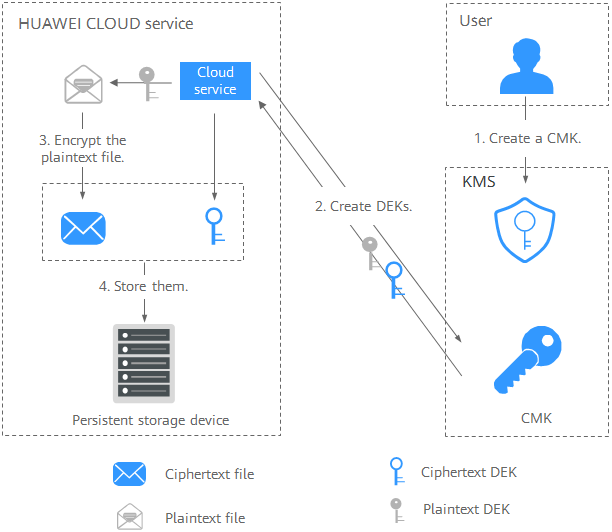Overview
After your cloud services are integrated with KMS, to encrypt data on cloud, you simply need to select a CMK managed by KMS for encryption.
You can select a default key automatically created by a cloud service through KMS, or a key you created or imported to KMS. For details, see What Is a Customer Master Key?
|
Category |
Service |
Encryption Mode |
|---|---|---|
|
Computing |
Elastic Cloud Server (ECS) |
You can encrypt an image or EVS disk in ECS.
|
|
Image Management Service (IMS) |
||
|
Storage |
Object Storage Service (OBS) |
|
|
Elastic Volume Service (EVS) |
||
|
Volume Backup Service (VBS) |
VBS generally creates online backups for a single EVS disk (system or data disk) of the server. If it is encrypted, its backup data will be stored in encrypted mode. |
|
|
Cloud Server Backup Service (CSBS) |
CSBS mainly creates consistency backups online for all EVS disks of the server. CSBS backups will also be displayed on the VBS page. If it is encrypted, its backup data will be stored in encrypted mode. |
|
|
Database |
RDS for MySQL |
|
|
RDS for PostgreSQL |
||
|
RDS for SQL Server |
||
|
Document Database Service (DDS) |
Encryption Process
Huawei Cloud services use the envelope encryption technology and call KMS APIs to encrypt service resources. Your CMKs are under your own management. With your grant, Huawei Cloud services use a specific CMK of yours to encrypt data.

- Create a CMK on KMS.
- A Huawei Cloud service calls the create-datakey API of the KMS to create a DEK. A plaintext DEK and a ciphertext DEK are generated.

Ciphertext DEKs are generated when you use a CMK to encrypt the plaintext DEKs.
- The Huawei Cloud service uses the plaintext DEK to encrypt a plaintext file, generating a ciphertext file.
- The Huawei Cloud service saves the ciphertext DEK and the ciphertext file together in a permanent storage device or a storage service.

When users download the data from the Huawei Cloud service, the service uses the CMK specified by KMS to decrypt the ciphertext DEK, uses the decrypted DEK to decrypt data, and then provides the decrypted data for users to download.
Feedback
Was this page helpful?
Provide feedbackThank you very much for your feedback. We will continue working to improve the documentation.






